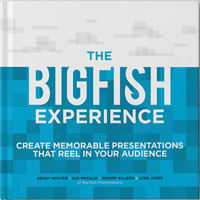The Essentials
Design Resources for the Everyday Presenter
Continuing our Christmas Gifts to our readers, we offer the next post in our The Essentials series. For the second part of this series, we are featuring design resources that anyone (those who aren’t designers by nature) can use.
If you are planning a slideshow presentation and would like to include photography/illustrations in your slide decks, here are three sites we recommend for design information, and five web resources for free and paid photography and graphics.… Continue Reading →
Content + Delivery Resources for the Everyday Presenter
As an early Christmas gift to our readers, we offer the first post in our new series The Essentials. We will feature compilations of our favorite posts that we recommend to everyone looking to improve their presentation game. For the first part of this series, we are featuring creating great content and powerful delivery.… Continue Reading →
 Ever feel like you’re talking at your audience, rather than talking to them? The brain begins to tune things out after an average of 9 minutes and 59 seconds- no matter how interesting you are. The trick to a great presentation is to keep your audience engaged. So, how do you do it?
Ever feel like you’re talking at your audience, rather than talking to them? The brain begins to tune things out after an average of 9 minutes and 59 seconds- no matter how interesting you are. The trick to a great presentation is to keep your audience engaged. So, how do you do it?
This week’s sample chapter “How to Involve Your Audience” from The Big Fish Experience explains how to hook your audience- and keep them hooked.… Continue Reading →

Last week we released a sample chapter from our latest book, The Big Fish Experience, and we hope it helped you learn a little bit about what makes a presentation simple, memorable, and understandable. As promised, this week our sample chapter focuses on “The Big Idea.”
This chapter is especially important because it defines your entire presentation. Behind every great presentation is a big idea; it inspires or challenges your audience to rally around a central idea. … Continue Reading →
 Our book is out and we want the world to know
Our book is out and we want the world to know
While, admittedly, we would love for you to rush to the stores and buy your own copy of The Big Fish Experience, we decided to share a total of five free sample chapters from our book over the next couple of weeks so you see what for yourself what The Big Fish Experience has to offer.… Continue Reading →
 Ever feel like you’re talking at your audience, rather than talking to them? The brain begins to tune things out after an average of 9 minutes and 59 seconds- no matter how interesting you are. The trick to a great presentation is to keep your audience engaged. So, how do you do it?
Ever feel like you’re talking at your audience, rather than talking to them? The brain begins to tune things out after an average of 9 minutes and 59 seconds- no matter how interesting you are. The trick to a great presentation is to keep your audience engaged. So, how do you do it?


